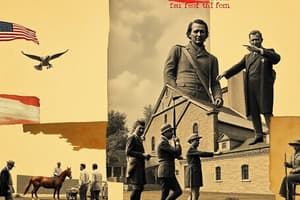Podcast
Questions and Answers
What significant document was adopted in 1776 to express the colonies' desire for independence?
What significant document was adopted in 1776 to express the colonies' desire for independence?
- The Treaty of Paris
- The Bill of Rights
- The Articles of Confederation
- The Declaration of Independence (correct)
The Boston Tea Party was a significant event during the period of American independence.
The Boston Tea Party was a significant event during the period of American independence.
True (A)
What major event tested the United States' resolve and strengthened its sense of national unity during the early republic?
What major event tested the United States' resolve and strengthened its sense of national unity during the early republic?
The War of 1812
The ________ of 1803 significantly expanded the territory of the United States.
The ________ of 1803 significantly expanded the territory of the United States.
Match the following events with their corresponding outcomes:
Match the following events with their corresponding outcomes:
What was a major political issue during the Era of Expansion and Reform?
What was a major political issue during the Era of Expansion and Reform?
The Industrial Revolution did not affect American society significantly between 1760 and 1860.
The Industrial Revolution did not affect American society significantly between 1760 and 1860.
What document established fundamental rights and freedoms after the ratification of the Constitution?
What document established fundamental rights and freedoms after the ratification of the Constitution?
What advancement significantly boosted productivity during the rise of industrialization?
What advancement significantly boosted productivity during the rise of industrialization?
The Kansas-Nebraska Act of 1854 had a calming effect on tensions regarding the expansion of slavery.
The Kansas-Nebraska Act of 1854 had a calming effect on tensions regarding the expansion of slavery.
What belief drove the idea of Manifest Destiny in American society?
What belief drove the idea of Manifest Destiny in American society?
The __________ movement gained momentum in the North, challenging the moral justification of slavery.
The __________ movement gained momentum in the North, challenging the moral justification of slavery.
Match the following acts or events with their effects:
Match the following acts or events with their effects:
Which party was formed in opposition to the expansion of slavery into new territories?
Which party was formed in opposition to the expansion of slavery into new territories?
The rise of factories and manufacturing marked a decline in the growth of cities.
The rise of factories and manufacturing marked a decline in the growth of cities.
What was a major consequence of the rise of political parties during this period?
What was a major consequence of the rise of political parties during this period?
Flashcards
Key Features of the Era (1760-1860)
Key Features of the Era (1760-1860)
The period from 1760 to 1860 in the United States marked by significant political, social, and economic changes, paving the way for the country's future.
What sparked the American Revolution?
What sparked the American Revolution?
British policies, including taxation without representation, angered colonists, leading to protests and boycotts.
American Revolution (1775-1783)
American Revolution (1775-1783)
The American Revolution was fought between the American colonies and Great Britain from 1775 to 1783. The colonists sought independence from British rule.
Declaration of Independence
Declaration of Independence
Signup and view all the flashcards
Treaty of Paris (1783)
Treaty of Paris (1783)
Signup and view all the flashcards
Challenges Faced by the Early Republic
Challenges Faced by the Early Republic
Signup and view all the flashcards
US Constitution
US Constitution
Signup and view all the flashcards
The Era of Expansion and Reform (1815-1860)
The Era of Expansion and Reform (1815-1860)
Signup and view all the flashcards
Manifest Destiny
Manifest Destiny
Signup and view all the flashcards
Industrialization
Industrialization
Signup and view all the flashcards
Abolitionism
Abolitionism
Signup and view all the flashcards
Slavery
Slavery
Signup and view all the flashcards
Urbanization
Urbanization
Signup and view all the flashcards
American Civil War
American Civil War
Signup and view all the flashcards
Industrial Economy
Industrial Economy
Signup and view all the flashcards
Agricultural Economy
Agricultural Economy
Signup and view all the flashcards
Study Notes
Key Features of the Era (1760-1860)
- The period saw significant political, social, and economic transformations in the United States, establishing the nation's future direction.
- Growing conflict between American colonies and Great Britain led to the American Revolution.
- The newly formed nation faced challenges in governance, westward expansion, and the debate over slavery.
- The Industrial Revolution greatly reshaped the American economy and society.
The American Revolution (1760-1783)
- Colonial discontent over British policies, especially taxation without representation, prompted protests and boycotts.
- Key events like the Boston Tea Party and the Intolerable Acts heightened tensions.
- The Revolutionary War (1775-1783) saw the colonies fight for independence.
- The Declaration of Independence (1776) outlined colonists' ideals of liberty and self-governance.
- The Treaty of Paris (1783) recognized the United States as an independent nation.
- Challenges included establishing a new government and managing the war effort.
The Early Republic and its Challenges (1783-1815)
- The newly formed government under the Articles of Confederation had significant governing problems.
- The Constitutional Convention of 1787 led to the creation of the US Constitution, strengthening the central government.
- Ratification of the Constitution and the Bill of Rights established fundamental rights and freedoms.
- States' rights became a major political issue.
- Early presidents like George Washington and John Adams struggled to define national identity and policy across diverse social and economic divides.
- The War of 1812 against Great Britain tested the nation's resolve and solidified national unity.
The Era of Expansion and Reform (1815-1860)
- Significant westward expansion and acquisition of new territories sparked debates concerning the expansion of slavery.
- The Louisiana Purchase (1803) greatly increased the nation's territory.
- The Monroe Doctrine (1823) positioned the US as a dominant power in the Western Hemisphere.
- Growing sectionalism intensified conflicts over states' rights, especially regarding slavery.
- Reform movements, including abolitionism, temperance, and women's suffrage, addressed societal issues.
- Industrialization transformed American society and economy, contributing to urbanization and the rise of new industries.
- Technological advancements like the cotton gin and steam engine improved productivity.
- Political parties like the Whigs and Democrats shaped the political landscape, fueling debates on economic and social issues.
- Manifest Destiny, the belief in American expansion across the continent, influenced westward expansion and territorial acquisitions.
Slavery and the Road to Civil War (1790-1860)
- Slavery was deeply entrenched in the Southern economy and society.
- Increasing tension between the North and South over slavery led to political debates and compromises (e.g., Missouri Compromise).
- The abolitionist movement gained strength, challenging the moral justification of slavery.
- The Fugitive Slave Act (1850) intensified sectional conflict.
- The Kansas-Nebraska Act (1854) heightened tensions over slavery expansion, exacerbating political divisions.
- The Dred Scott decision (1857) further complicated the slavery debate, upholding the right to take slaves into free territory.
- Increasing political division and new parties added to the growing crisis.
- Abraham Lincoln's election in 1860 triggered the secession of Southern states, leading to the American Civil War.
Economic Transformations (1790-1860)
- The transition from an agricultural to an industrial economy was crucial.
- New inventions and technologies significantly boosted productivity.
- Growing trade led to the development of transportation like canals.
- Infrastructure like roads and canals stimulated economic activity and connected different regions.
- Factories and manufacturing alongside urban growth arose.
- A more complex financial system developed alongside increased trade with other countries.
Studying That Suits You
Use AI to generate personalized quizzes and flashcards to suit your learning preferences.
Description
This quiz explores the significant political, social, and economic changes in the United States between 1760 and 1860. Covering the American Revolution, issues of governance, and the Industrial Revolution, it highlights key events and their impacts on the nation's future. Test your knowledge on the foundational years that shaped America.




